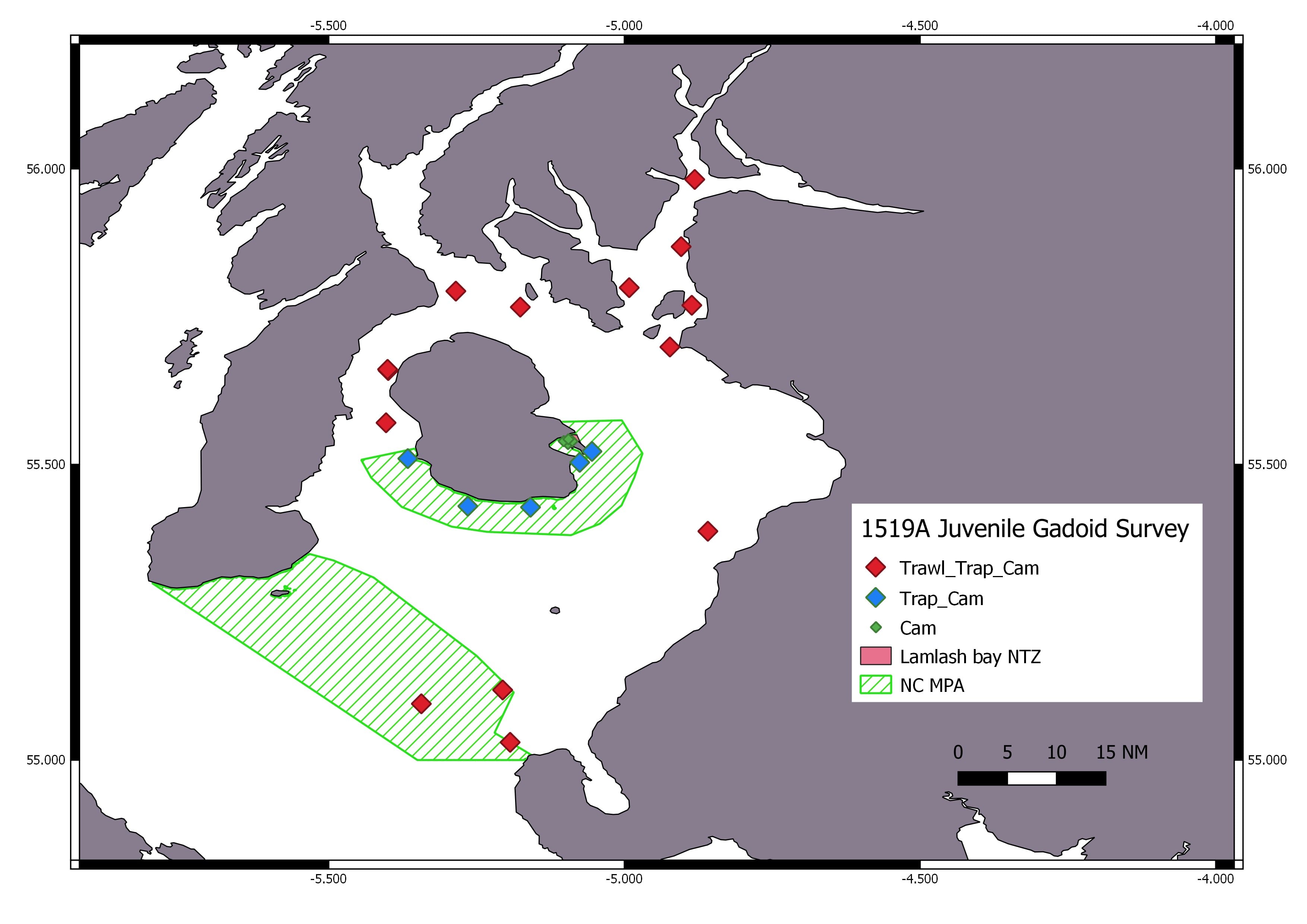Marine
Juvenile Fish Habitat
September 3, 2019 by Marine Directorate Communications No Comments | Category Marine Directorate general, Marine Directorate Science, Research Vessel Surveys
MRV Alba na Mara
Survey: 1519A Programme
Duration: 2-21 September 2019
Gear:
- 2 x Jackson Rockhopper Trawl BT158 with 10 mm Cod end + Spare
- Scanmar net sensors – trawl width, height, and depth (x2 units)
- 2 fleets of fish traps
- Fish/prawn sorting table
- SBRUV – baited camera frames – (QTY 2)
- 2 x Day grab, grab table
Background and Objectives:
1519A will conduct a benthic survey of juvenile gadoids within the Firth of Clyde. The primary objective of 1519A is to identify whether the availability, quality and distribution of habitat acts as a constraint on the number of juvenile fish that can grow and be recruited into the adult population.
This study focusses on three gadoid species with differing habitat preferences; Atlantic cod, whiting and haddock, all of which the year-class strength appears to be established around the period of settlement to the demersal habit. The study will utilise three sampling methods: demersal tows, fish traps, and baited-camera census techniques. Data from these surveys will inform the development of species distribution models at a regional and stock scale and will also be used to compare the selectivity of the three sampling methods. Otolith based survivorship analyses will also be carried out post-survey to examine selection on settlement time and size-specific mortality. Genetic tissue will be stored and used post-survey to examine stock structure, primarily in cod. Habitat will be characterised using a combination of hydro-acoustic recordings (RoxAnn) for seabed classification and sediment grab samples.
Specific survey objectives are as follows:
- To collect data on juvenile gadoid abundance using three different sampling methods.
- To record substrate features at the point of sampling.
- To collect sufficient otolith samples suitable for survival analysis studies.
- To collect sufficient genetic material to investigate issues relating to stock structure.
Embarkation:
Scientists will join the vessel on the morning of 2 September. Weather permitting, Alba na Mara will depart on the same day, heading for the first survey site. IMPORTANT NOTE: It is essential that the wet lab freezer is completely empty before embarkation.
Survey Work:
The survey will be split into four distinct activities – demersal trawling, fish trap work, baited camera work, and a survey of the substrate – which will be performed at each station.
1. Demersal Fishing Survey
The demersal survey (30 minute tows) will assess the abundance, length-frequency-distribution, and weight-at-length of juvenile gadoids at 14 fixed stations within the Firth of Clyde (Figure 1- Trawl_Trap_Cam). Otoliths of five individuals per 1 cm size class will be retained for analysis at a later date. Occurrences of invertebrates and other fish species will be recorded and measured.
Scanmar units will be fitted to the wings and head line of the BT158 trawl to ensure the net is fishing correctly.
2. Fish Trap Survey
A fish trap survey at all demersal survey sites (Figure 1- Trawl_Trap_Cam) and within the NC MPA (Figure 1- Trap_Cam) within the Firth of Clyde will be carried out during 1519A. Traps (up to two fleets of four traps) will be deployed in the first half of the day and collected in the afternoon after a soak time of approximately six hours. Species composition and length frequency distributions of fish caught will be determined. All samples will be weighed and, where appropriate (cod, whiting, haddock), frozen. Occurrences of invertebrates and other fish species will be recorded and measured.
3. SBRUV baited cameras
In addition to demersal and fish trap survey sites (Figure 1- Trawl_Trap_Cam and Trap_Cam), stereo Baited Remote Underwater Video Camera (SBRUV) frames will be deployed in the No Take Zone (Figure 1 Cam) during daylight hours (2-3 units will be available). These will be left in the water for approximately 1.5 hrs before being retrieved. The deployment of baited cameras will happen at the same time as that of the fish traps and at distances sufficient to avoid any interaction with either the fleet ground gear or the other baited system (recommended minimum is 500 m). Footage will be downloaded to external media at the end of each working day. Species type, relative species densities (MaxN) and substrate type (assessed visually) will be classified post-survey.
4. Substrate Classification
To further aid the classification of the substrate at each sampling site, 1519A will also acquire RoxAnn records of the surveyed area and a Day grab will be deployed. Sediment samples will be collected from each grab and stored in the freezer. These will be analysed on return to the laboratory to determine particle size distribution in the sediment at each sample location.
Operations:
Survey operations will take place between the hours of 07:00 and 19:00 (all times BST). Stations will be surveyed depending on the prevailing weather conditions i.e. if wind strengths or wave heights are adverse, a precautionary approach will be adopted and those with adequate shelter from the weather will be selected. Alternatively, in poorer weather the trawl survey may be prioritised over other activities.
A half landing will be provisionally booked for a suitable port on 11 September to comply with working hours and to allow planned changes to the scientific crew.
Alba Na Mara will leave the study area in the morning of 20 September to allow sufficient time for the vessel to transit to Oban. Unloading will occur in Oban on Saturday 21 September. Scientists will disembark at this time.
Further Information:
Tags: 1519A, Alba na Mara, Firth of Clyde, fish trap survey, hydro-acoustic recordings



Leave a comment